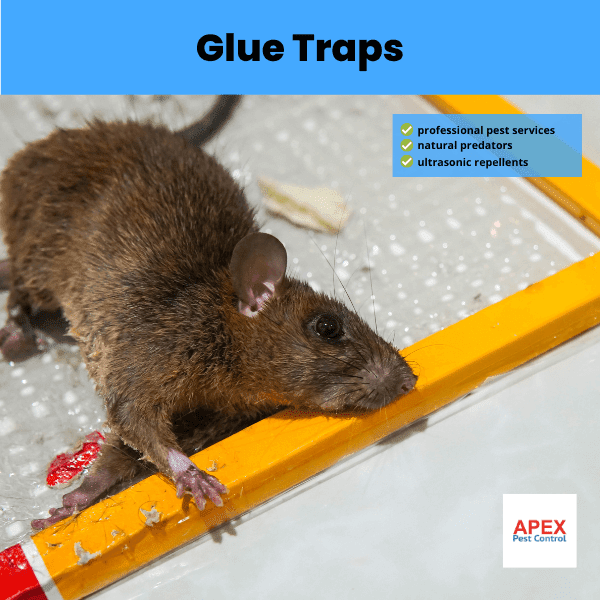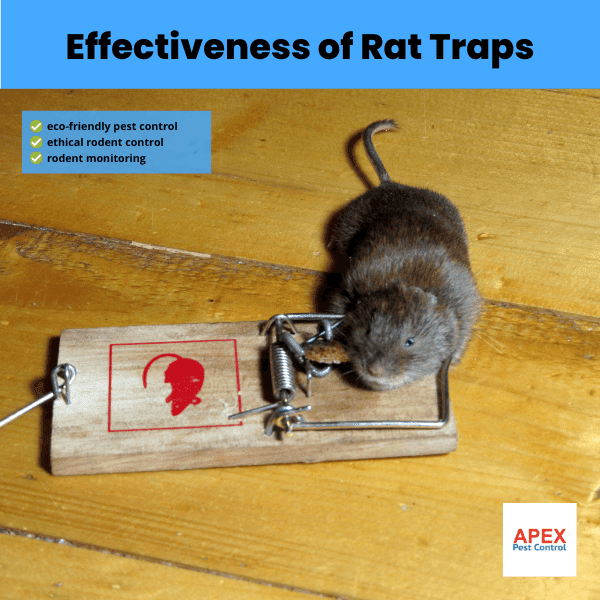Rat Traps: Your Comprehensive Guide to Effective Rodent Control
At Apex Pest Control, we understand the importance of effective rat control methods. This comprehensive guide explores various rat trap options, helping you choose the best solution for your rodent problem.
Discover our detailed guide on Effective Rat Repellents, highlighting reliable solutions and practical tips to protect your space from rodents.
Types of Rat Traps

Snap Traps
Description and Design
Snap traps are a traditional and widely used type of rat trap. They typically feature a spring-loaded metal bar that snaps down when triggered by the rodent. The bait is placed on a pressure-sensitive switch, enticing rats to activate the trap.
Key Features:
- Spring-loaded mechanism
- Pressure-sensitive trigger
- Various sizes available for different rat species
Pros and Cons
Pros:
- Quick and effective
- Reusable and economical
- Allow for easy disposal of rodents
Cons:
- Potential risk to pets and children if not properly secured
- May cause some mess if not checked regularly
Apex Pest Control Tip: We recommend using expanded-trigger snap traps, as research shows they have fewer bait losses and almost twice the capture rate of narrow-trigger versions.
Live Catch Traps

Description and Design
Live catch traps are designed to capture rats without causing them harm. They typically use doors that close upon entry, effectively trapping the rodent inside. Some models allow for multiple catches before needing to be emptied.
Key Features:
- Non-lethal capture method
- Multiple-catch options available
- Various sizes to accommodate different rat species
Pros and Cons
Pros:
- Humane option for those who prefer not to kill rats
- Allow for relocation of captured rats
- Can catch multiple rats with a single setting
Cons:
- Requires more frequent checking
- Necessitate a plan for releasing captured rats
- May not be suitable for large infestations
Glue Traps

Description and Design
Glue traps consist of adhesive-coated sheets or boards that immobilise rodents once they step onto them. They are often baited in the centre areas to attract targets.
Key Features:
- Adhesive coating
- Flat design for easy placement
- Often include attractants or bait
Pros and Cons
Pros:
- Simple to use
- Inexpensive
- Effective for monitoring rat activity
Cons:
- Considered inhumane by some due to prolonged suffering
- Can catch non-target animals
- Less effective in dusty or damp areas
Apex Pest Control Note: While glue traps can be effective, we prioritise more humane and targeted methods of rat control.
Electronic Traps

Description and Design
Electronic rat traps deliver a high-voltage shock to kill rodents quickly. These units typically have an internal chamber where rats enter seeking bait, triggering the lethal electrical circuit.
Key Features:
- Battery-powered
- Enclosed design for safety
- Indicator lights for successful catches
Pros and Cons
Pros:
- Quick and humane kill
- Safe around children and pets when used properly
- Easy to clean and maintain
Cons:
- More expensive than traditional traps
- Requires battery changes
- May not be suitable for outdoor use
How to Use Rat Traps

Proper Placement
Effective trap placement is crucial for successful rat control. Consider the following guidelines:
- Place traps along walls where rats typically travel
- Position traps with the trigger facing the wall
- Use multiple traps, spaced 15-20 feet apart in areas of high activity
- Place traps in dark, sheltered areas where rats feel safe
Baiting Techniques
Choosing the right bait can significantly increase your trapping success:
- Use high-quality, fresh bait
- Opt for protein-rich baits like peanut butter, bacon, or nuts
- Secure bait firmly to the trap to prevent theft
- Change bait regularly to maintain freshness
Safety Measures
When using rat traps, always prioritise safety:
- Keep traps out of reach of children and pets
- Wear gloves when handling traps and disposing of rats
- Clean and disinfect the area after removing trapped rats
- Follow local regulations for rat disposal
Effectiveness of Rat Traps

Factors Influencing Effectiveness
Several factors can impact the success of your rat trapping efforts:
- Proper trap placement
- Quality and freshness of bait
- Number of traps used
- Consistency in checking and resetting traps
- Addressing the root causes of rat infestations
Comparison of Trap Types
Different trap types have varying levels of effectiveness:
| Trap Type | Effectiveness | Humaneness | Ease of Use |
|---|---|---|---|
| Snap Traps | High | Moderate | Easy |
| Live Catch | Moderate | High | Moderate |
| Glue Traps | Moderate | Low | Easy |
| Electronic | High | High | Easy |
Ethical Considerations
Humane Treatment of Rats
At Apex Pest Control, we prioritise humane pest control methods. Consider the following when choosing rat traps:
- Opt for traps that provide quick, painless kills
- Check traps frequently to minimise suffering
- Consider live traps if you prefer non-lethal methods
Environmental Impact
Be mindful of the environmental impact of your rat control methods:
- Avoid using poisons that can affect non-target wildlife
- Properly dispose of trapped rats to prevent disease spread
- Address sanitation issues to prevent future infestations
Alternatives to Rat Traps

Natural Predators
Encouraging natural rat predators can be an effective, eco-friendly control method:
- Barn owls
- Domestic cats
- Certain dog breeds
Rat Repellents
While less effective than traps, repellents can be used as part of an integrated pest management approach:
- Ultrasonic devices
- Natural repellents like peppermint oil
- Chemical repellents (use with caution)
Professional Pest Control Services
For severe infestations or ongoing rat problems, professional services like Apex Pest Control offer:
- Comprehensive property inspections
- Customised treatment plans
- Use of advanced, eco-friendly control methods
- Follow-up visits and maintenance plans
Maintenance and Disposal of Rat Traps

Cleaning and Reusing Traps
Proper maintenance extends the life of your traps:
- Clean traps with hot water and disinfectant after each use
- Check for wear and tear regularly
- Replace traps that show signs of damage
Safe Disposal Methods
When disposing of trapped rats:
- Wear protective gloves
- Double-bag the rat carcass
- Dispose of in outdoor trash receptacles
- Follow local regulations for proper disposal
Tips for Preventing Rat Infestations

Home and Yard Cleanliness
Maintain a clean environment to discourage rat activity:
- Store food in airtight containers
- Clean up pet food and bird seed
- Keep outdoor areas free of debris and overgrowth
Sealing Entry Points
Prevent rats from entering your property:
- Seal holes and cracks in foundations
- Install door sweeps and weather stripping
- Cover vents and chimneys with mesh
Regular Inspections
Conduct routine checks to catch infestations early:
- Inspect attics, basements, and crawl spaces regularly
- Look for signs of rat activity like droppings or gnaw marks
- Address any potential food or water sources promptly
Summary of Key Points
- Choose the right trap type based on your specific situation and ethical considerations
- Proper placement and baiting are crucial for trap effectiveness
- Regularly maintain and clean traps for optimal performance
- Combine trapping with prevention methods for long-term rat control
- Consider professional pest control services for severe infestations
At Apex Pest Control, we’re committed to helping you maintain a rat-free environment using effective, humane, and environmentally responsible methods. For expert assistance with rat control or any other pest issues, don’t hesitate to contact our team of professionals.
Questions and Answers Related to Rat Traps
How effective are ultrasonic rat repellents?
Ultrasonic repellents have limited effectiveness. Rats may initially avoid areas with these devices but often become accustomed to the sound over time.
Can rats escape from glue traps?
Yes, rats can sometimes escape from glue traps, especially if the trap is too small or the adhesive is weak. Larger rats are more likely to break free.
Are electronic rat traps humane?
Electronic rat traps are considered more humane than some alternatives as they deliver a quick, lethal electric shock, minimising suffering.
How often should I check rat traps?
Check rat traps daily to prevent odours from dead rats and to reset or rebait as needed. More frequent checks may be necessary for heavy infestations.
What’s the best bait for rat traps?
Peanut butter, bacon, or nuts are highly effective baits for rat traps. Rats are attracted to foods high in protein and fat.
Can rats learn to avoid traps?
Yes, rats can become “trap-shy” if they encounter a trap and escape. They may also learn to avoid traps if they see other rats caught in them.
Are there any eco-friendly rat traps?
Yes, catch-and-release traps and some plant-based repellents offer eco-friendly alternatives to traditional rat control methods.

Tony Johnson, Founder & Lead Technician at Apex Pest Control, is a BPCA and NPTA accredited pest management expert with over 35 years’ hands-on experience. Tony specialises in Integrated Pest Management and ensures all services comply with UK pest legislation, including the Wildlife and Countryside Act 1981 and COSHH Regulations 2002. His commitment to continual learning and adapting to industry best practices means clients receive effective, safe solutions for pests affecting homes and businesses across South Yorkshire. Tony’s dedication to professional standards, ethical treatment methods, and local expertise has made him a trusted partner for pest control and prevention.
-
BPCA & NPTA accredited | CHAS certified
-
Committed to UK pest law compliance & safety
-
Focused on effective, ethical pest management for South Yorkshire


